Most children adore playing with playdough. They squish it, pinch it, roll it, cut it, and, sometimes, unfortunately, stick it up their respective noses. Its place in pre-school art lessons is well understood, but is playdough a STEM activity?
Yes, playdough is a STEM activity. It is a cheap material to make models for STEM lessons, from basic shapes to the solar system or digestive system. It is a safe medium to use when designing structures such as marble runs. It is also a fantastic substance for when children are learning about electricity.
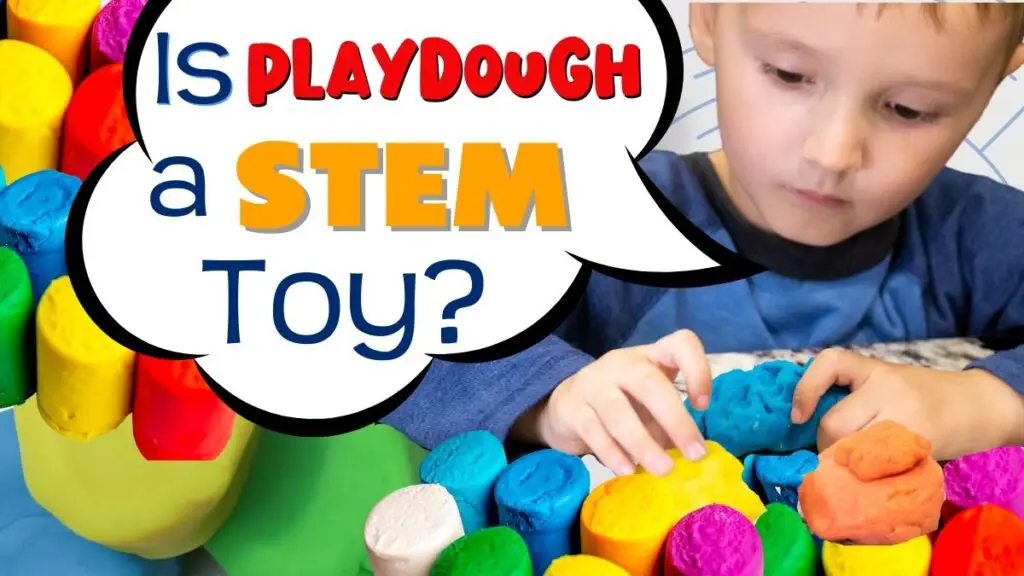
Some believe playdough is more of a STEAM (science, technology, engineering, art, and mathematics) activity. Yes, playdough is a STEAM activity as well. Overall, we try not to get too hung up in the debate between STEM vs STEAM. Both have their merits, and we enjoy mixing a bit of art in our STEM.
Given art contributes to creativity, an attribute required for success in a STEM career, the more artistic side of playdough is a definite bonus. Playdough relates to STEM in many ways, right from the start where chemistry is required to make it. (We’ll share our favorite recipe for DIY homemade play dough down below.) Grab your favorite color dough and let’s explore!
Playdough is Good for Foundational STEM Skills
Playdough Recipes
Playdough Chemistry
Playdough STEM Activities
*We’re an affiliate – we may earn a commission through qualifying purchases from the links on this page. As always, thanks!*
Playing with Playdough is Good for Foundational STEM Skills
Behind the STEM acronym are a lot of foundational skills necessary for a successful career. These skills form the unseen base of STEM and include curiosity, creativity, problem-solving, entrepreneurship, and critical thinking. Playdough provides an easy way for children to be creative, and simple STEM projects will spark their curiosity and get them thinking.
Like many foundational STEM toys such as good old LEGO bricks, playdough also develops hand-eye coordination and fine motor skills. This “basic” yet crucial stage of children’s development helps work and stimulate the brain in ways beneficial to STEM learning. This is why so many STEM activities aimed at younger children also enhance these two skills.
Playdough is a versatile material that is wonderful to incorporate in STEM challenges and lessons.
Making Playdough is a STEM Activity
Yes, you can buy playdough, and I’m grateful, as it does save time. However, given how young children gob things and lick their fingers, we prefer to make our own whenever possible. More importantly: making playdough is a STEM activity; it’s a chemistry lesson to be specific.
First, let’s take a look at our go to recipe, and we’ll get to the chemistry in a bit.
Playdough Recipes
You’ll find many DIY playdough recipes are variations on salt dough. The main ingredients are flour, salt, cooking oil, water, cream of tartar (or another stabilizer – more on this below), and hot water. The quantities or ration of ingredients may vary slightly. We’ll share what works best for us, and you can feel free to tweak to your liking. It’s all about experimentation, after all.
Our Favorite Play Dough Recipe
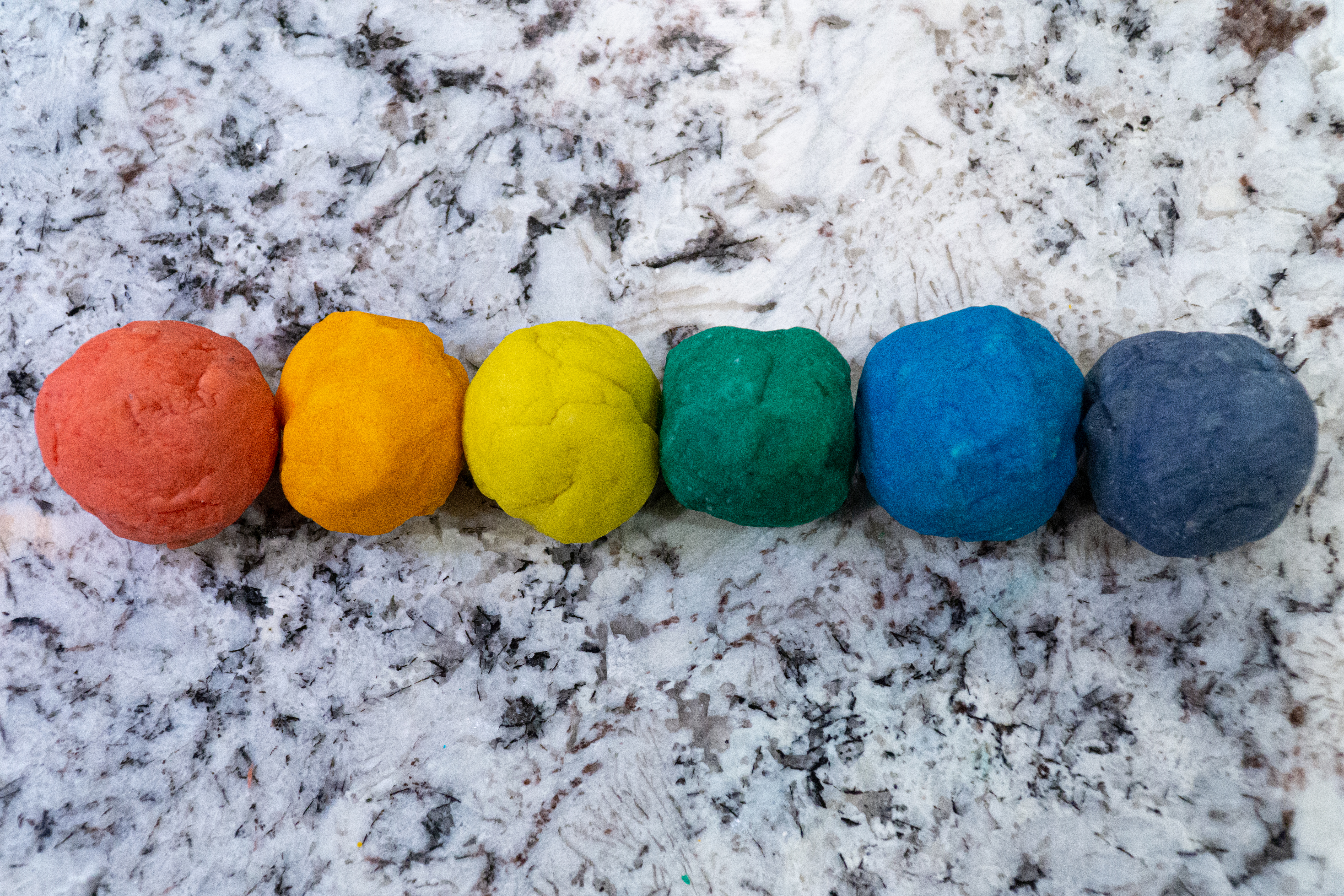
- 2 Cups of Flour
- 1/2 Cup of Salt
- 2 Tablespoons Cream of Tartar
- 2 Tablespoons of Cooking Oil (we use coconut oil, though vegetable oil will work fine)
- 1 1/2 Cup Boiling Water
- Food Coloring (gel coloring works best)
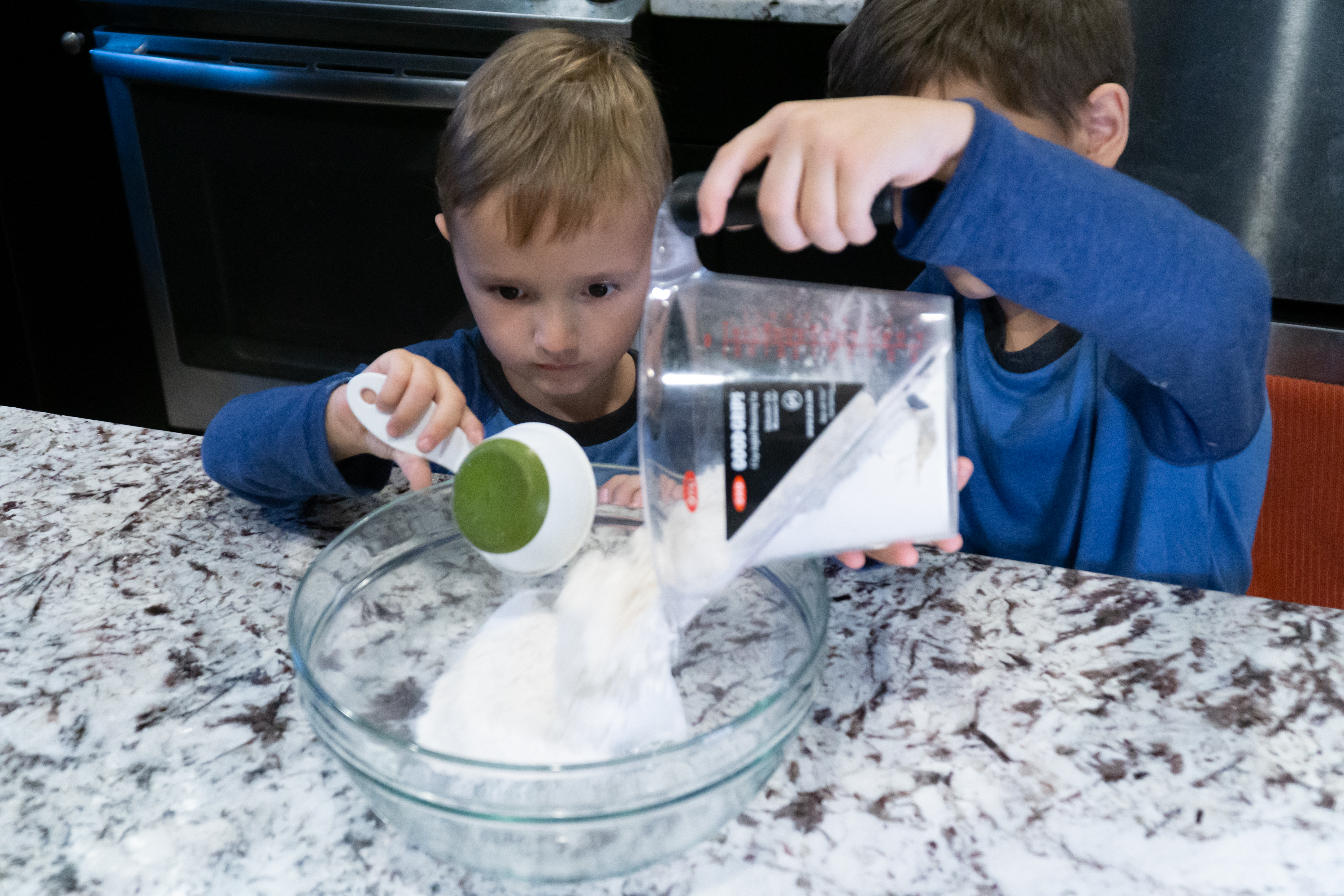
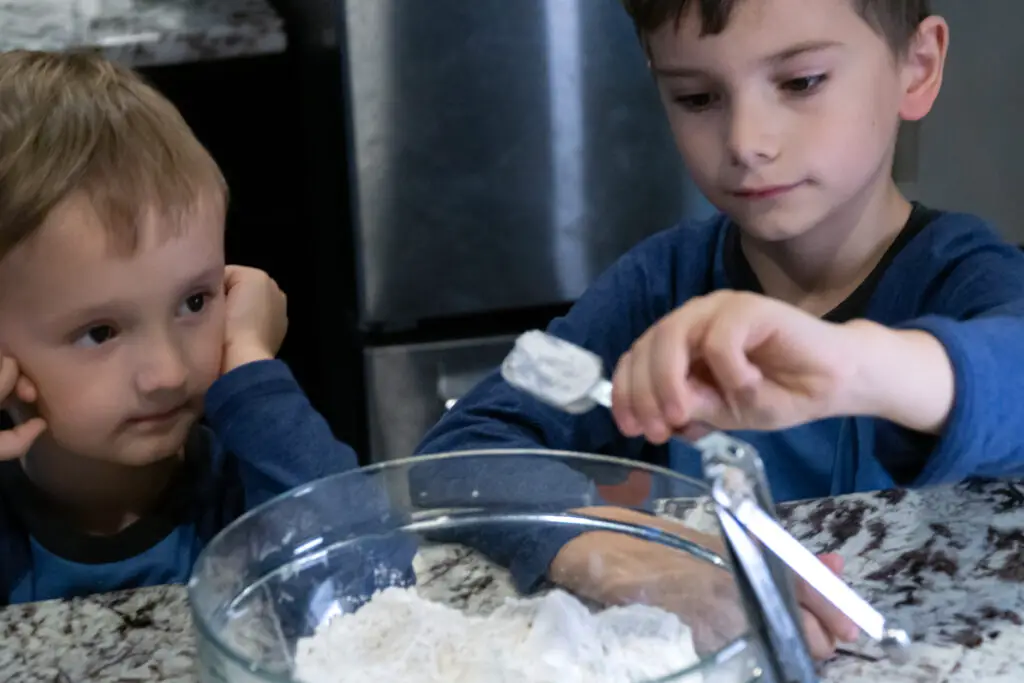
- Combine the flour, salt, and Cream of Tartar in a mixing bowl.
- In a sauce pan, combine the water and oil and bring it to a slow boil, then reduce to a low to medium heat.
- If you want a large batch of the same color, this is the time to add the food coloring (and least messy!) If you want to divide the batch into different colors, you can add the coloring later.
- Gradually mix in the dry ingredients and stir. It’s tempting to want to get your hands in there and start mixing and kneading right away, but be careful; the dough is hot!
- Feel free to adjust your ingredients. If it’s a bit runny or viscous, add more flour. If it’s too flaky or crumbly, add more cream of tartar or a bit more oil.
- Once you’ve got a good consistency to the dough, let it cool
- If you opted not to add coloring while mixing, you can separate smaller lumps of dough and make a variety of colors by adding the coloring now. It’s easiest to make a thumbprint indentation in the dough, add a few drops of coloring, and knead it in. Warning – this can get messy and stain hands and countertops if you’re not careful.
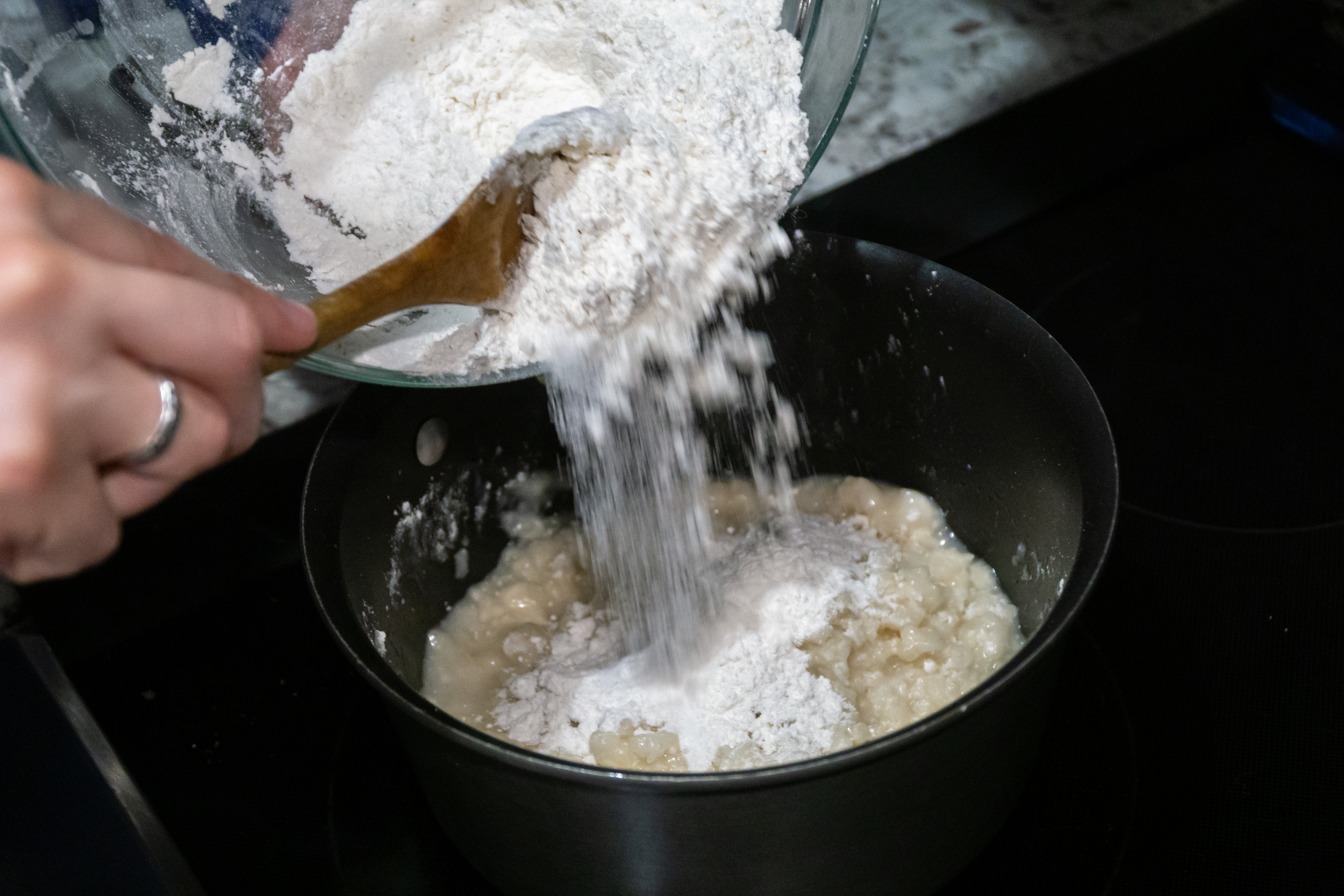
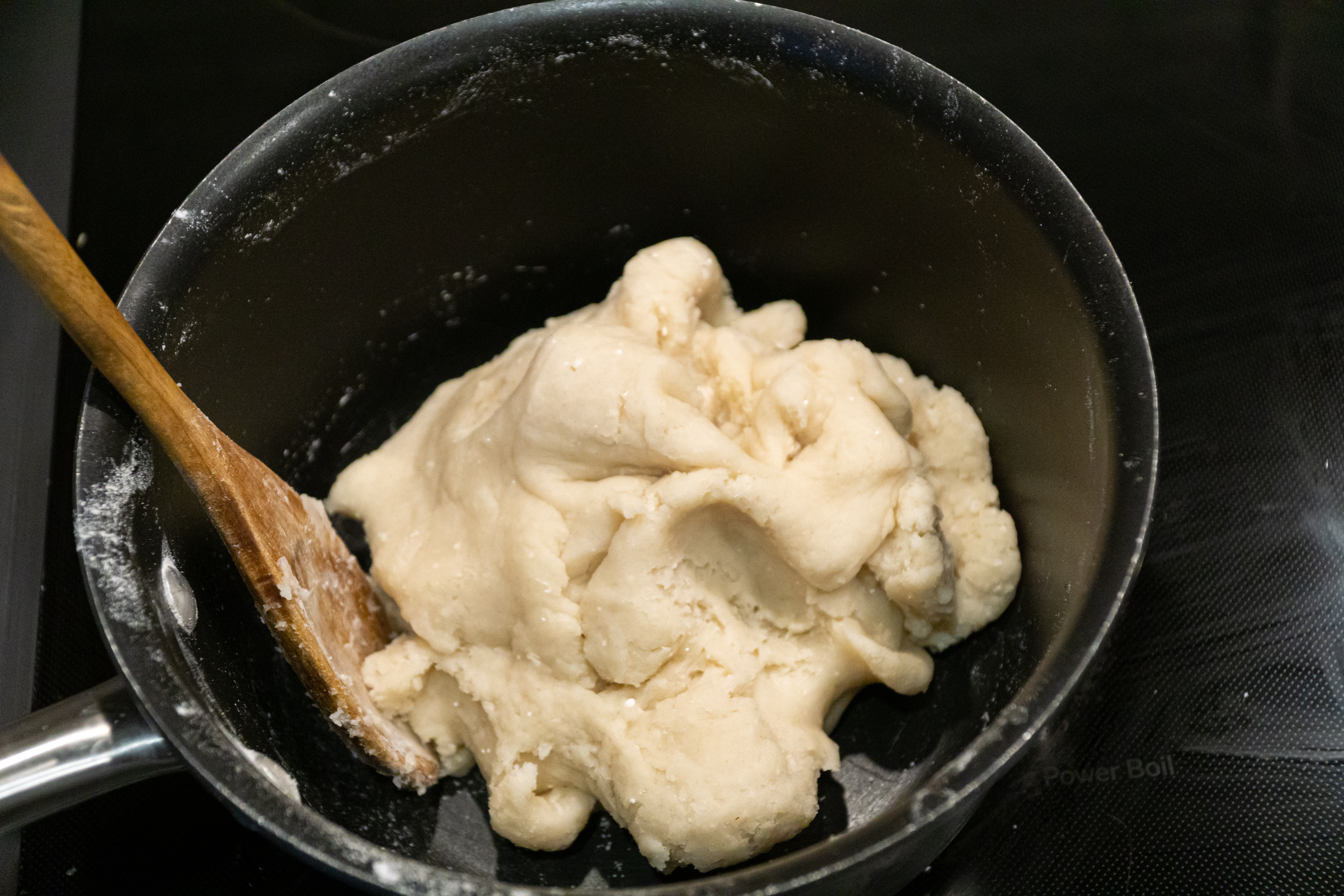
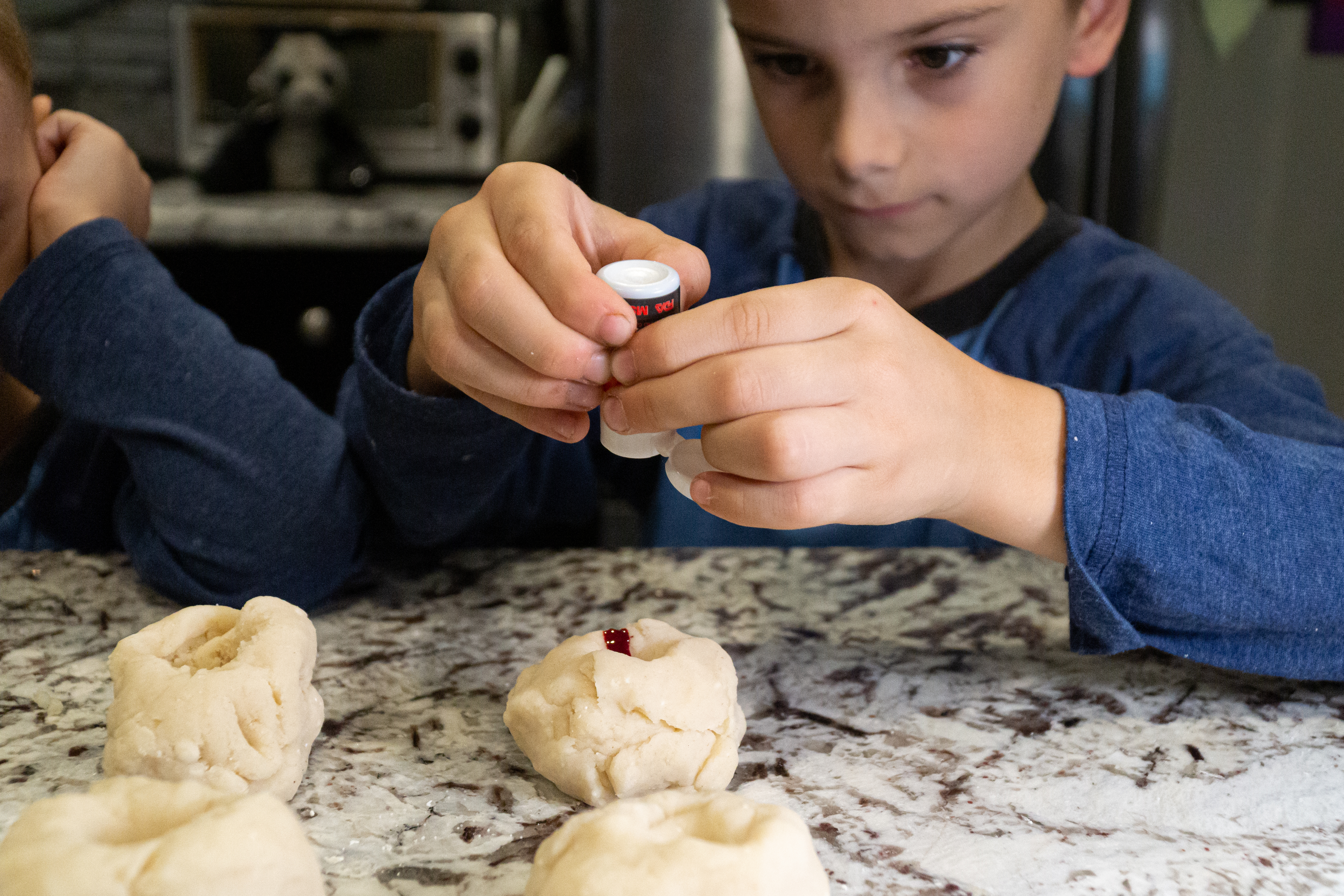
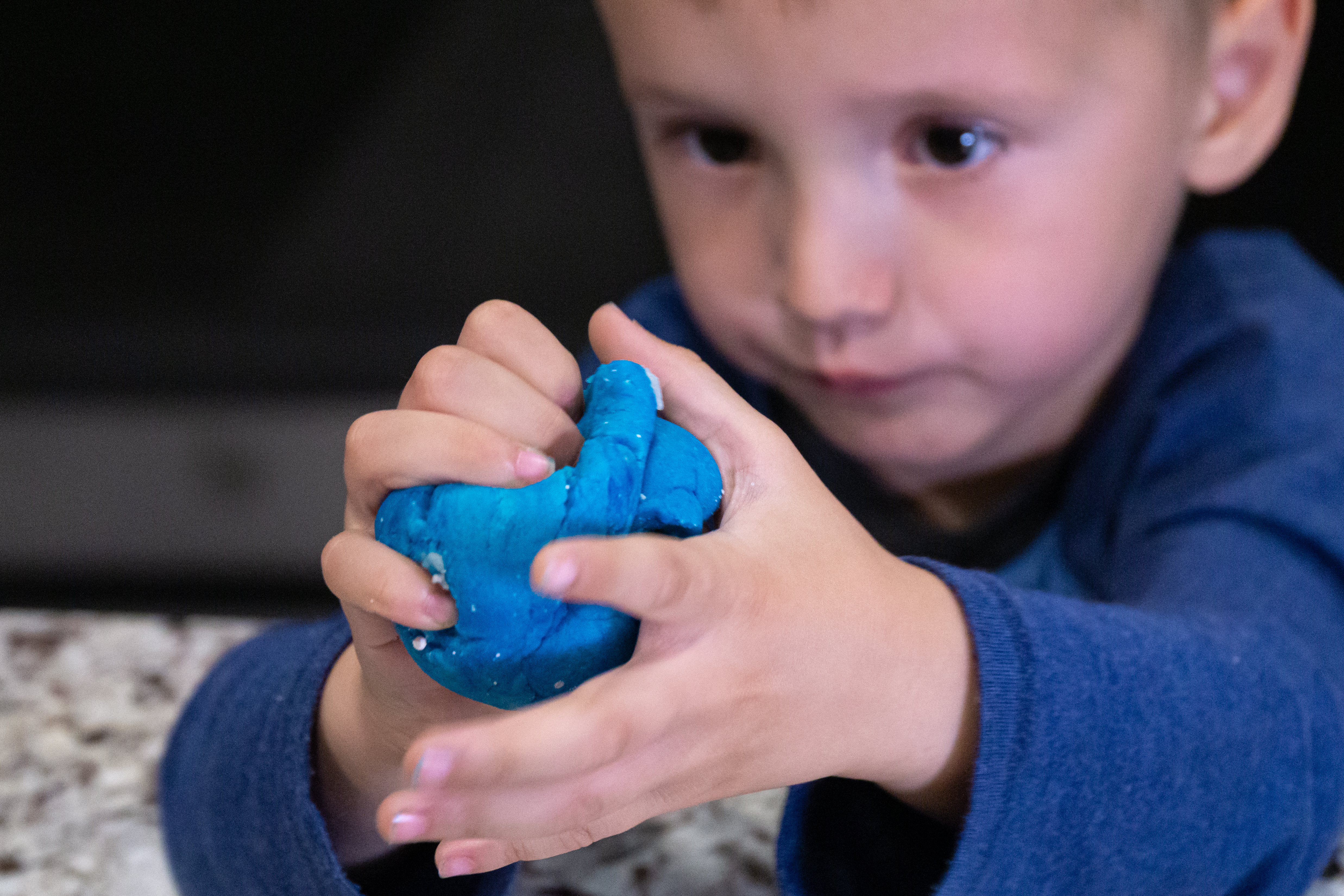
Store the playdough in an airtight container. Ziplock bags or Tupperware containers work great (or a ziplock back placed in a tupperware container if you want to be extra airtight. There is no need to refrigerate. It will last for months. Well, depending on the children’s antics, of course.
If your play dough dries out, you can try adding a little bit of oil to it and kneading it in to bring it back to a nice soft texture.
Variations:
You can spice up your dough by adding a few drops of scented oils (peppermint or cinnamon are nice) or add in some glitter for some sparkles.
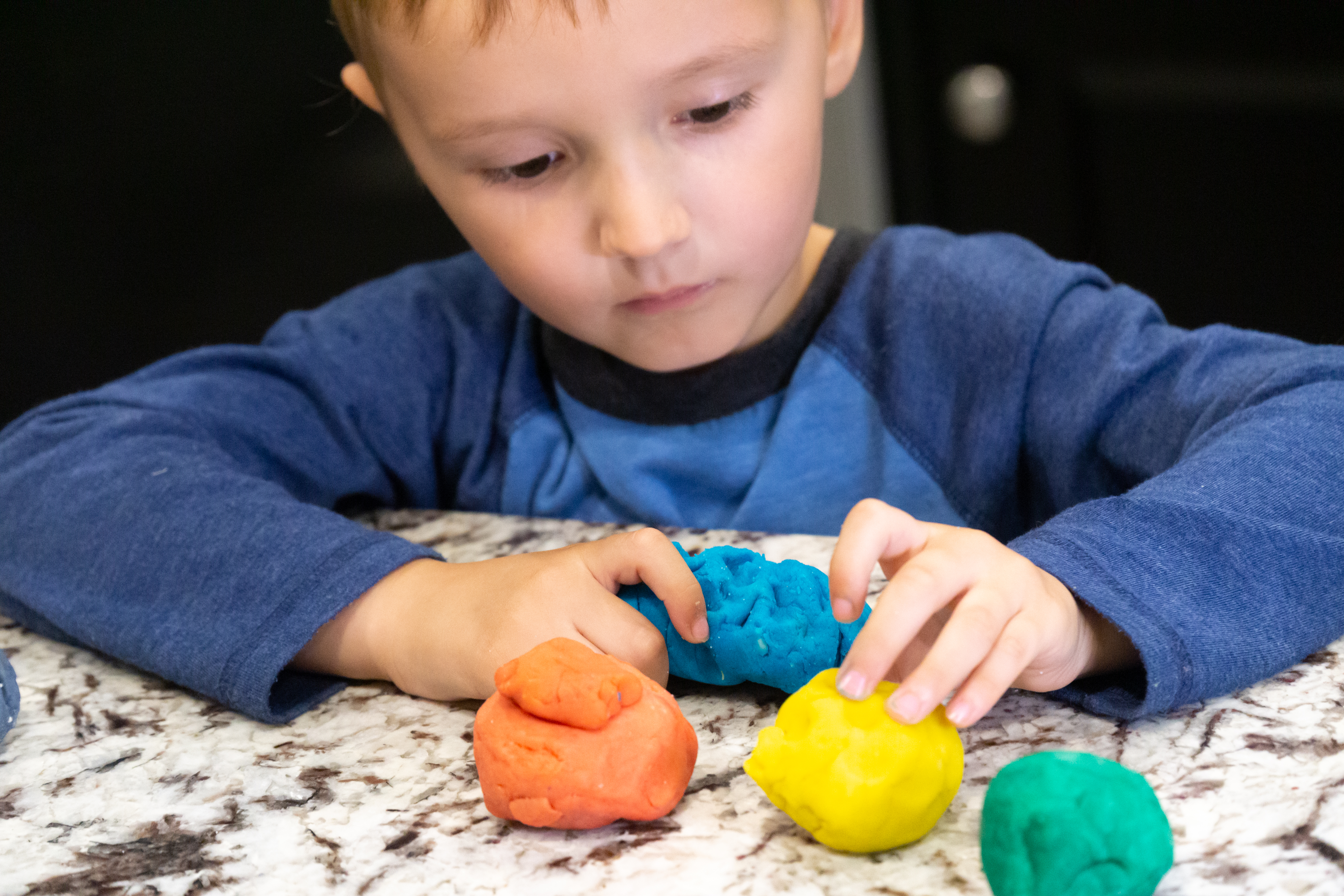
Making Playdough a Chemistry Lesson
When you are making playdough from the above recipe, a chemical reaction occurs thanks to the cream of tartar and the heat. Cream of tartar is an acid: potassium bitrate, also known as potassium hydrogen tartrate. There is a slight fizz when it is added to water.
Cream of tartar is a byproduct of wine making, and is commonly used when making scrambled eggs or whipping egg whites or cream. This is because it stabilizes the cream or egg white.
Adding cream of tartar to mixtures with sugar also prevents crystals from forming. It keeps things smooth. If cream of tartar is mixed with baking soda, it becomes a leavening agent commonly sold as baking powder.
In our playdough recipe, cream of tartar acts as a bonding agent. Thankfully, we don’t end up with a lump of wet gooey, salty flour when making playdough. It is also what helps give playdough its incredibly smooth texture, despite the high quantity of salt.
The salt is primarily acting as a preservative, so the dough doesn’t spoil immediately. If you dried out your playdough, the salt would hold it together as a crumbling mess, sure, but that’s no fun. The cream of tartar holds it together. Cream of tartar also has a long shelf life (much longer than baking soda. Between the salt and the cream of tartar, homemade playdough lasts quite a while.
Quick and Easy Playdough Recipe
Here’s a 2 ingredient playdough recipe for when you need a super quick activity. It’s not our go to recipe but good if you’re missing an ingredient, short on time, or the kids just really want some playdough.
You just need 2 ingredients:
- 2.5 cups corn starch
- 1 cup hair conditioner
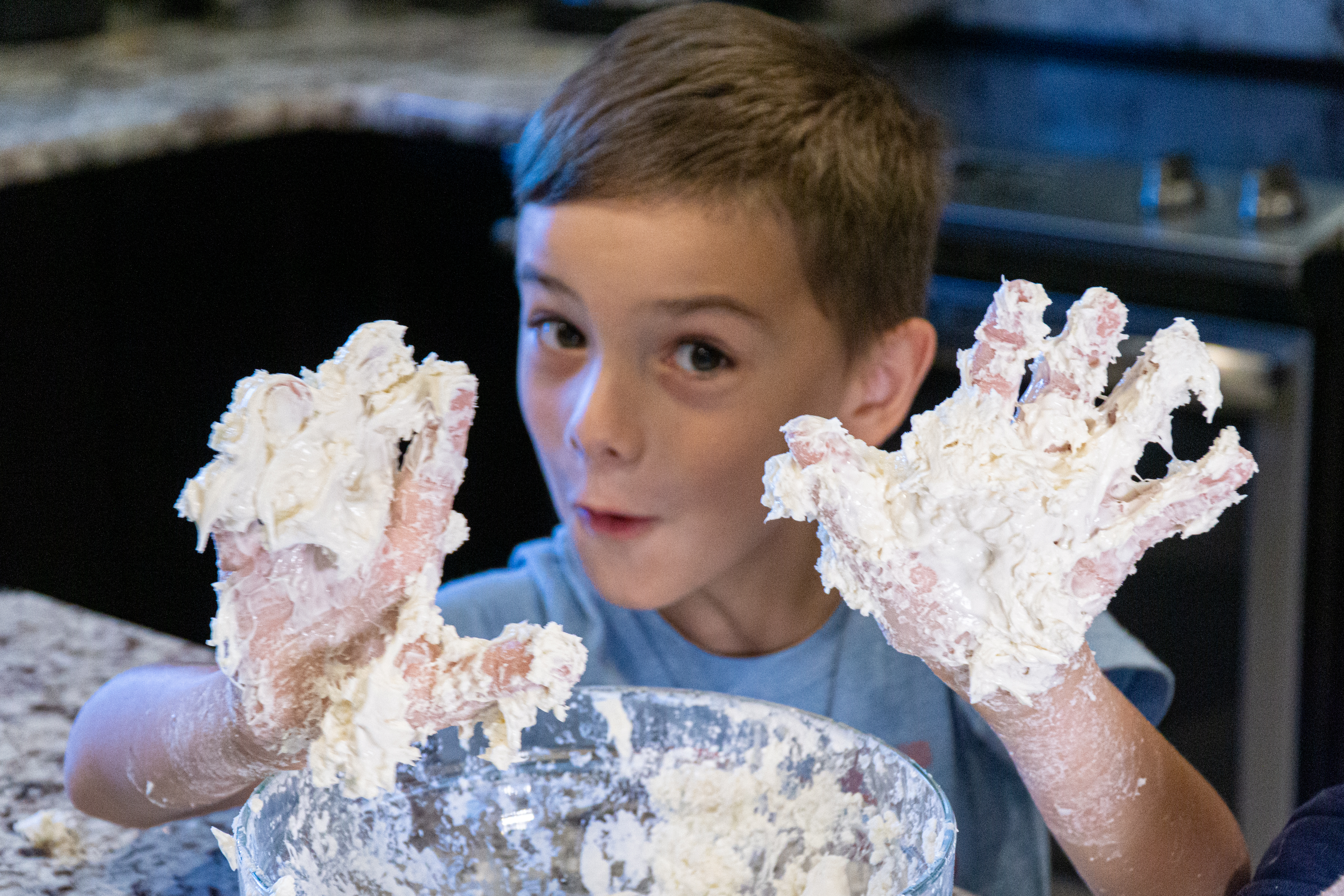
Just combine the corn starch and conditioner in a bowl and kneed it until it’s a uniform consistency. If it’s a bit too goopy, you can add a bit more cornstarch to thicken it up. If it’s too flaky, add a bit more conditioner until you get a smooth texture.
This mixture doesn’t take dye as well as the salt dough recipe above, though you can still get some colors if you want to add some food coloring.
Corn starch is the main ingredient in our non-Newtonian slime, which you can check out in our gross science activities. We also let used this in our dinosaur dig.
Playdough STEM Activities
Whether you use the “official” store bought stuff or prefer to make your own homemade playdough, here are some of our favorite ways to learn with playdough.
Dinosaur Fossils
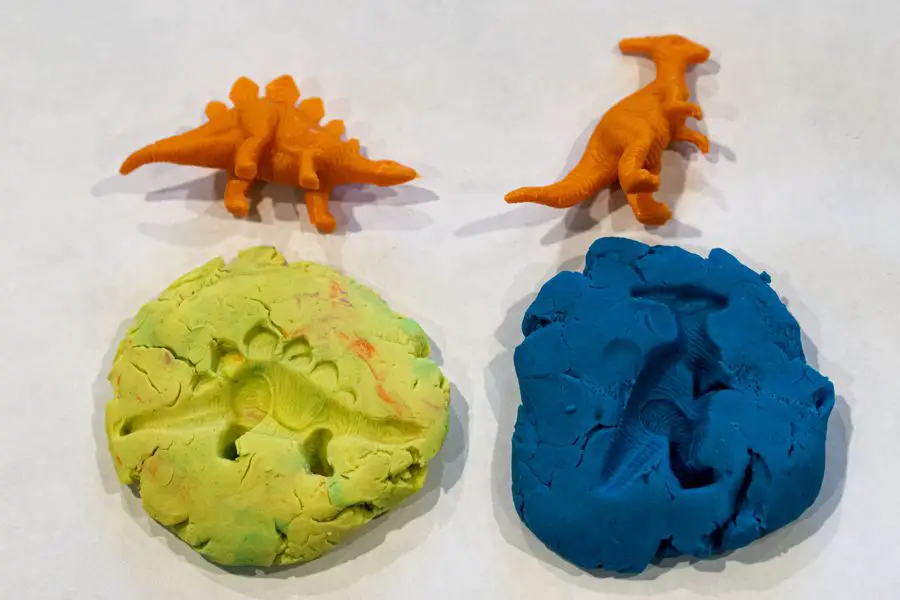
Did someone say dinosaurs?! Count us in! Our kids love anything to do with dinosaurs so it was easy to teach them about fossils with this quick STEM activity. Our toddler loved making dinosaur footprints and smooshing his toy dinosaurs into the dough. You can make dinosaur impressions or tracks by pressing toy dinosaurs into the dough.
Using Playdough is a great alternative to making plaster fossil activities, especially for younger children.
You can take another approach using some molds made from plastic or, better yet, silicone. Amazon, for instance, provides an excellent variety. Here are some examples :
Okay – it doesn’t have to be all dinosaurs all the time. Here’s a few others that are fun:
Making Models Playdough STEM Activities
A lot of science lessons, from anatomy to the layers of the earth, can be taught using playdough.
- Create a human brain or models of other organs for an anatomy lesson.
- Layer different colors to create an earth model from the core to the earth’s crust.
- Why stop there? Make a model of the Earth with blue sea and green continents. Sculpt mountain ranges and geographical features.
- Explore the galaxy and make the entire solar system using playdough.
Making science models with playdough is a fun and hands-on STEM activity.
Math with Playdough Mats
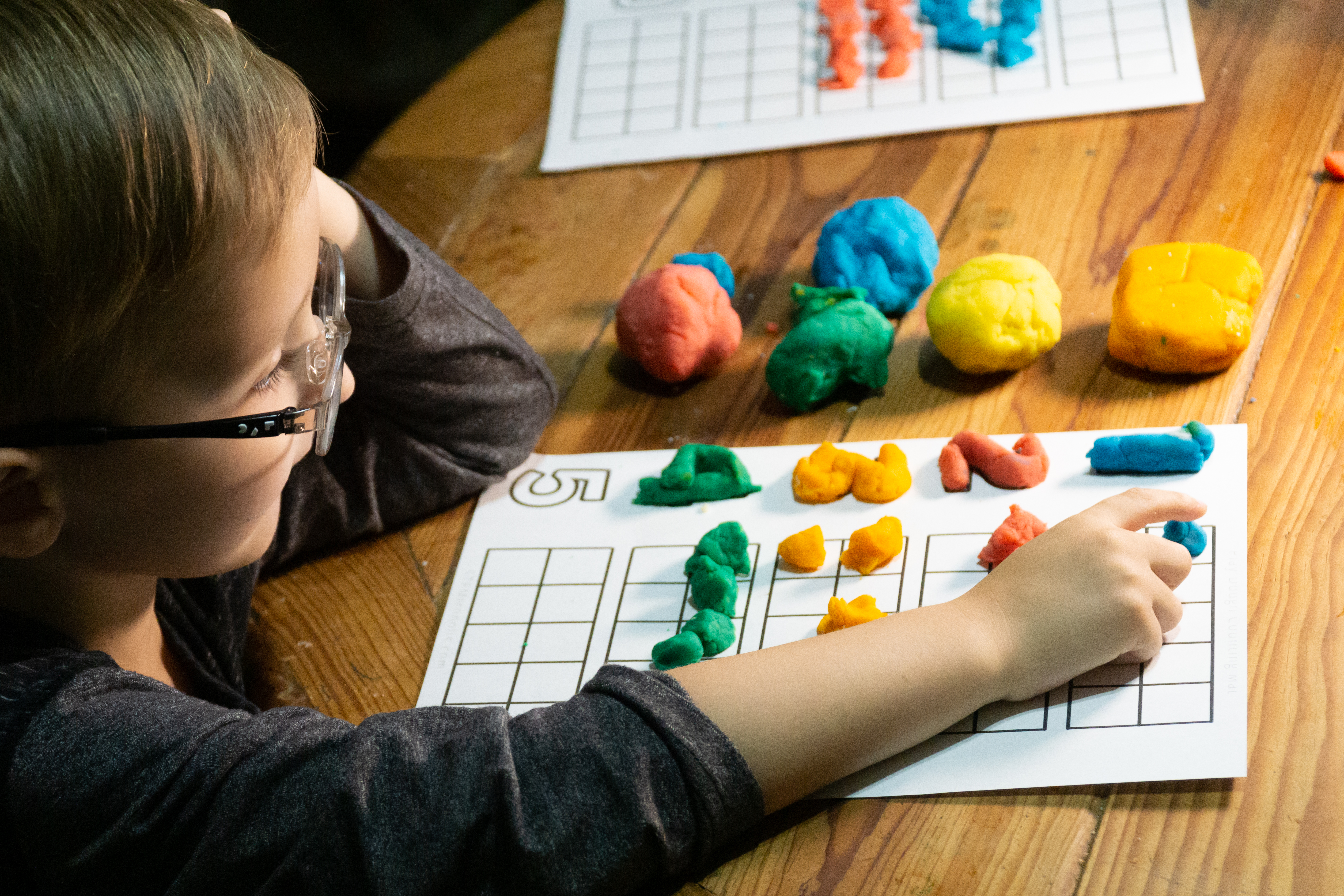
You can use playdough to do math exercises and games. We have a free play mat that you can download for a fun, hands-on STEM activity for young mathematicians. Simply print out the file and start having fun counting numbers 1 through 10. You can use playdough to shape the numbers, and make paydough balls to put in the grid next to each number.
If you want to use the mat over and over, you may want to laminate it. Use the sign up form below and get access tot he counting mat and our whole free printables library:
Building Challenge Playdough STEM Activity
Use different materials and playdough to challenge the children to build as high as they can. Depending on the age, the more complex or tricky the materials can be. Suggestions:
- Buttons
- Craft Sticks
- Large paperclips
- Macaroni
- Old Keys
- Spaghetti
- Straws
- Toothpicks
Try to have the kids use at least two to three materials. This will make them have to modify their techniques to achieve a build. For example, fragile items, like spaghetti, require tinier balls of playdough than keys which will need greater globs for support. Then ask them questions.
Examples:
- What modifications did they make between builds? Why?
- What were the challenges of each material they used?
- What material did they enjoy building with most? Why?
Squishy Circuits STEM Activity
Squishy circuits allow children to build creatures, like a snail or a unicorn, out of dough and then light it up and make it beep using electricity. This is such a creative and fun way to teach children the basics of electrical circuits.
Coding Playdough STEM Activity
The clever folks at Makey Makey have produced a STEM product that combines design, electricity, and coding. One of the activities is using the conductive properties of playdough to make your own video controller (another is using bananas). An amusing, engaging, and highly educational STEM project with numerous possibilities
Egg Drop Playdough STEM Challenge
Like any other egg drop challenge, you can provide various building materials such as toilet rolls, bubble wrap, pipe cleaners, straws, string, and wire. The goal is to design a structure to protect the egg and keep it from cracking or breaking when dropped.
In this challenge, the kids cannot use tape or glue, but only playdough as their binding material. This one can be messy, but hilarious.
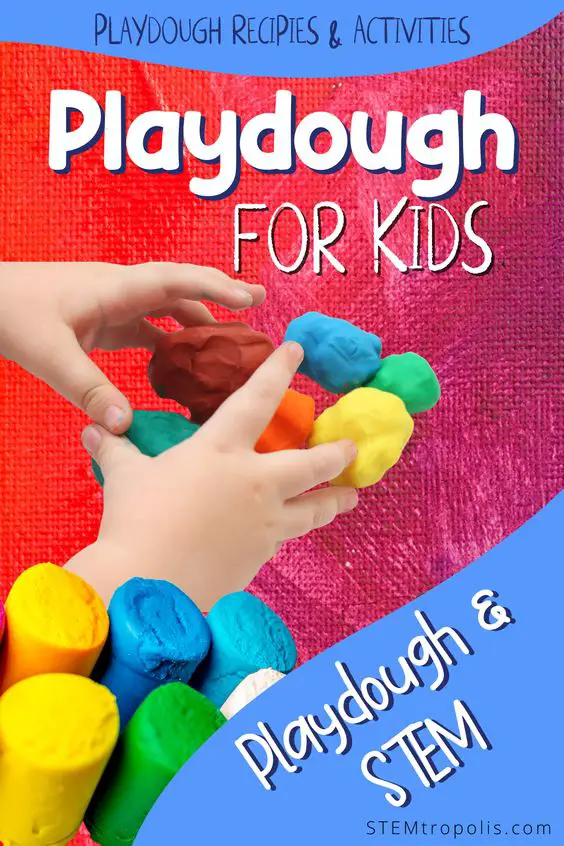
Wrap Up – Is Playdough a STEM Activity?
Playdough is a versatile material that makes an excellent companion to STEM lessons, from the basic chemistry that it’s made from to the endless STEM Challenges and science experiments you can do with it. Its conductivity makes it useful to teach electricity. Its binding properties are wonderful when doing building challenges and making models.
Add to that the creativity and art aspects of molding and shaping sculptures and playdough is a STEAM activity. But most of all, playdough makes learning fun.
We love playdough because it offers a wide range of fun activities for kids. It’s a sensory toy that provides hands on learning and motor development. Playdough is a toy that fosters, no – demands, open ended play. It’s a medium for sculpture and art.
Whether you need something for a simple STEM challenge, science experiment, or just want to squish it between your fingers and sculpt something, you can do it with playdough.


